So we decided to try each approach and see which works better. To make the experiment fair we set some rules:
use same budget for each stage (we agreed on $25 USD);
don't change tags and titles of promoted listings;
don't change prices of the promoted listings (the price range is $100 - $250 USD)
use same listings and shop section of the shop;
use only one type of promotion at a time (either listing renewals or promoted listings);
Listing renewals
First stage of the experiment was using listing renewals. We had $25 USD budget for selected shop section with 26 items. It's almost a dollar for each product listing. For each listing renewal Etsy charges you $0.20 USD. This means that with our budget we'd have $25 / $0.20 USD = 125 renewals. We also agreed to renew random item of the selected shop section every 2 hours within time range 6AM - 9PM when our target audience was most active. It's easy to figure out that we would need about 125 / 8 = at least 15 days to spend our budget. Every day we would run 8 renewals resulting in 8 * 0.20 USD = $1.60 USD per day ($1.60 USD * 15 = $24 USD) and 5 renewals on the last day of the stage resulting in 0.20 USD * 5 = $1 USD. The total budget was $25 USD for 15+ days (~$1.60 USD per day).
Every Etsy seller knows that manual listings renewals are quite annoying. When you have to do it every 2 hour - it's a pain. That's where we decided to use listing auto renewals tool and created an automated schedule based on our needs: renew random items from specific section every 2 hours from 6AM to 9PM until we spend $25 USD budget. Perfect!
To monitor our listings positions in search we used another great tool. Here you can see our listing renewal experiment graph for "knit shawl" keyword:

As you can see the graph line was somewhat flat until Jun, 20 when the experiment started. After that top item's position started floating due to our renewal schedule: we were renewing random items causing the line go up and down.
Also on this graph you can see that top item reached position #2 officially after the end date of the experiment, but that was a result of the previous day renewal which appeared on the graph on June 6th.
So by the end of the first stage the top item position in search for "knit shawl" increased from #21 to #2 which is pretty good. Of course they will drop again and rise again, but that is normal as other items in search get renewed too, gain likes and views too etc. But you can clearly see how you can improve your positions in search with automated listing renewals.
Here is more detailed graph of how positions for "knit shawl" keyword were changing during the experiment for each listing:
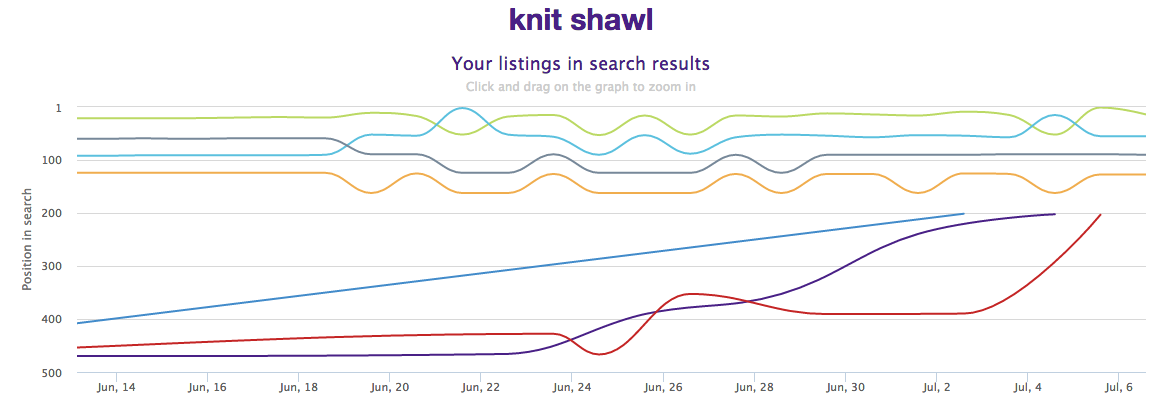 It's easy to notice on the second graph that items ranking fairly low significantly improved their positions! For example, the lowest shown item was #466 at the beginning of the experiment. After we stopped the experiment it was #203. That's half way through to the top! However it doesn't mean that if you keep renewing longer the position will still be increasing. But it's definitely a great way to improve your items positions in search. Not a lot of customers will go up to 10 pages of search results, 4-5 pages seems more realistic.
It's easy to notice on the second graph that items ranking fairly low significantly improved their positions! For example, the lowest shown item was #466 at the beginning of the experiment. After we stopped the experiment it was #203. That's half way through to the top! However it doesn't mean that if you keep renewing longer the position will still be increasing. But it's definitely a great way to improve your items positions in search. Not a lot of customers will go up to 10 pages of search results, 4-5 pages seems more realistic.
Promoted listings
The second stage of our experiment was using of Etsy promoted listings on Etsy. Please keep in mind that our total budget for each stage was $25 USD and we wanted to make both stages as similar/fair as possible.
So we set our promoted listings settings to this:

Daily budget was set to $1.79 USD to cover two weeks period for the experiment with $25 USD budget ($25 USD / 14 days = $1.79 USD per day). Maximum cost per click was set to $0.20 USD to be equal to the listing renewal cost. Setting the daily budget doesn't guarantee that it will be spent as well as setting max bid doesn't mean that each click will cost $0.20 USD.
Interesting thing here, we noticed that item that was on the first page in search results by "knit shawl" search term got more then 50% of all impressions and clicks. Which means that position in search does matter on how often your item will be showed in promoted listings.
To be exact, our first page item has got 11690 impressions during this experiment and our 3rd page item has got only 200 impressions with the same bid. So the positions in search do matter for your promoted listings bid/performance.
Here you can see the graph for impressions during this stage:
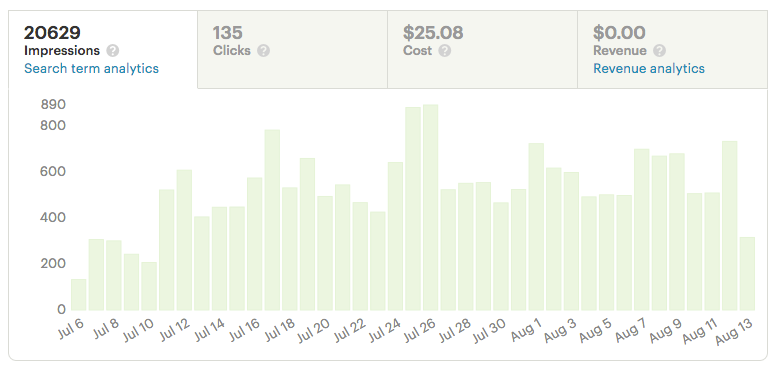
During this experiments amount of clicks varied from 1 to 8 with average of 4 clicks per day with different cost. Here is the graph for clicks:

All clicks resulted in $25.08 USD, which spread this way during the experiment:
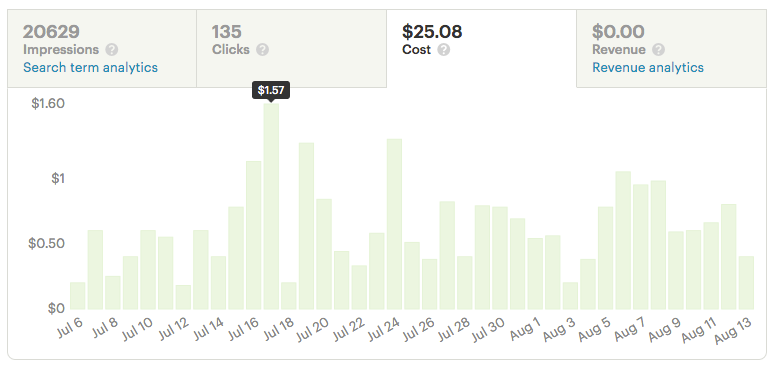
The highest spent amount in a day was $1.57 USD, which is lower then $1.79 USD we hoped for. As you can see daily average cost per click was lower than $1 USD, that's why second stage of the experiment took almost twice as long as first stage.
And here is a screenshot from search terms analytics sorted by impressions number:
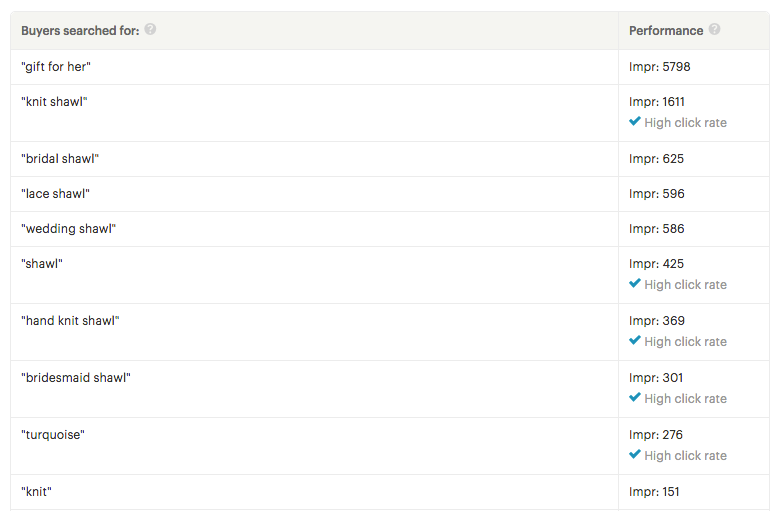
As you can see top search term by impressions is "gift for her", which is understandable due to its popularity on Etsy. However, this term didn't get highest click rate as knitted shawl is pretty specific product. So when customers search for a gift they will probably click on something else (a bit cheaper, smaller, more usual gift). These terms are chosen by Etsy automatically based on the titles and tags in each listing. It would be more flexible if sellers were able to choose specific search terms for ad campaigns to make them work better for their shops.
Here is a top 5 search terms with highest click rate:
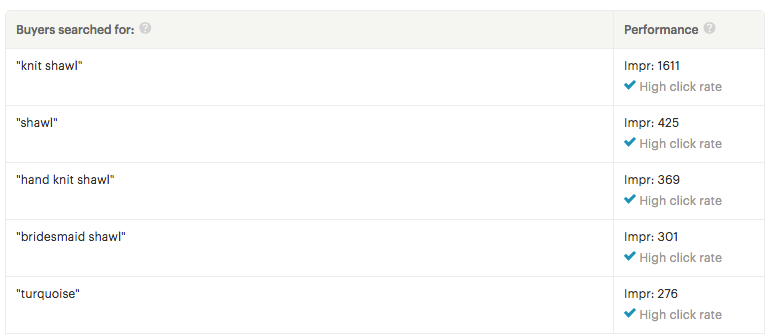
Most of them have "shawl" in a search term. The 5th search term is for a color, which is very specific too so it works great.
The results
It's great to rank higher in search, but it means nothing if it doesn't result in sales, right? The items we used in the experiment weren't low priced. The price range was $100 USD - $250 USD. Not many buyers would buy them without hesitation or thinking about this kind of purchase for a couple of days. It wouldn't be an impulse buying for sure.
Listing renewals stage
By the end of the experiment we got one sale of knit shawl. It was one of the recently relisted shawls which had increased its position in search. Moreover, after we analyzed Etsy shop stats we saw that customer came from the search results and bought the item right away. That purchase resulted in $130 USD in revenue. Simple math: $130 USD (revenue) - $25 USD (listing renewals budget) = $105 USD of income from the sale.

There were also additional orders ($70 USD) from this same customer later but as long as customer has found the shop from "knit shawl" search we can also add that revenue to this experiment results. Which would make it to $175 USD income from our experiment.


Promoted listings stage
The promoted listings didn't bring any sales. Also we didn't notice any increase in likes from potential customers. So overall promoted listings didn't bring any revenue. Of course, there is a chance that some of the customers who saw the items in promoted listings section and liked them will return in the next month to buy but that would be impossible to track.
The conclusion
It was a surprise that promoted listings didn't work as we thought. And even more surprisingly that listing renewals performed so great.
If your goal is to improve positions in search and get more sales from organic views we would suggest using listing renewals approach. It will get your products higher ranking at least for some time. It's always good to do some work on your SEO for the products you are going to renew. This promotion approach is transparent for your customers as they don't see "Ad" mark for your promoted listings. The downside is that there is no guarantee that listing will show up on first pages of the search results. In the process and after the experiment we noticed a lot of likes coming from potential customers. And chances are that more sales will come in the next couple of weeks as a result of previous and upcoming likes from people seeing the products in search results. But don't forget that each listing renewal costs $0.2 USD.
On the other hand Etsy promoted listings allow you to show up on first pages of the search results. However they don't look like regular organic Etsy search results due to "Ad" mark on each of the promoted listings. You can easily set your max bid and daily budget.
P.S. there is no any guarantee that this experiment results will be similar for your shop. There are too many variables: the price difference, product type, target audience, listing images, etc. The only way to figure that out is to try and see. And we encourage you to do so.
Don't hesitate to contact us if you have any questions or need help with your experiment!
Happy sales!


















